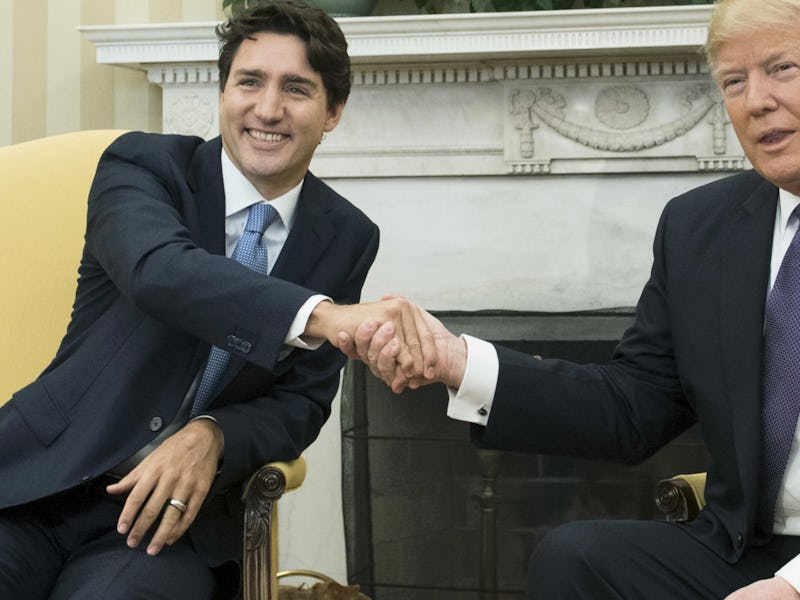
On Monday, Canada’s Prime Minister Justin Trudeau met with President Donald Trump to discuss the relationship between the two nations and to exchange a series of handshakes. The first of these, exchanged on the steps of the White House, was by far the most awkward — a tangle of aggressive grips and arm pats culminating in a wave to the cameras. It shouldn’t come as a surprise that both men went in for the first firm clasp: Scientific research has shown that a handshake isn’t just a hello — it’s the chance to make an aggressive first impression.
There’s a lot going on in their first handshake: Trump has his hand out ready to shake before Trudeau even arrives, offering it up vertically with a curved thumb up and at an angle. This transitions into a handshake in which Trump’s hand is on top while his left arm grips Trudeau’s shoulder. Then he moves into his signature power move: the right arm push. Trudeau, a boxer, holds his ground so the power push ends up becoming an awkward game of tug of war. (At least it was less awkward than Trump’s handshake with Shinzo Abe.)
Research published by, appropriately, a team of Canadian and American researchers, demonstrates that when Trudeau and Trump shook hands, they were subconsciously processing signals in a region of the brain called the amygdala. Their study in the Journal of Cognitive Neuroscience shows that when participants watch videos of animated characters shaking hands, the part of the amygdala that controls social cognition is activated. When the amygdala is activated, the brain can begin the autonomic and cognitive process of deciding what to do with information its given. Whether or not a person deliberately means to send a social signal with their handshake, they signal something to the brain’s social center nonetheless.
And that signal is powerful: The researchers write that nonverbal behavior has “five times the impact of verbal messages on judgements of a communicator’s friendliness and liking for the message recipient.”
Trump employs the power push.
While the brain reacts automatically to a handshake, body language specialists do say that certain shakes are purposefully employed to create an impression. According to The Definitive Book of Body Language, an over-the-top handshake (like the one that Trump is using in the image above) means that the person with their hand on top is trying to communicate that they are in control of the situation (this is also the same shake President Vladamir Putin tried with President Barack Obama). The person on the bottom of the handshake either lost the race to get on top — or they might be allowing the other person to only think they have control. According to University of Manchester scientists, the handshake that perfectly conveys an equal relationship is one with a firm squeeze, lasts for two to three seconds, and has three shakes. The first Trudeau-Trump handshake interaction, comparatively, lasted for about 14 seconds.
Trudeau seemingly considers whether or not he wants to go for it.
Science also suggests that another handshake-related event happened off-camera: After each handshake, it’s likely that Trump and Trudeau took a sniff of their palm. According to research from the Olfactory Lab at the Weizmann Institute of Science, people tend to subconsciously sniff their hands after a shake to pick up on chemical signals from the other person — it’s much like a dog might sniff another dog’s butt. These signals can tell us about the person’s physical health and mental state and add to the overall picture we are creating about their character. So the two heads of state spent much of their day shaking hands for the camera, but they probably spent some of that day sniffing each other out as well.